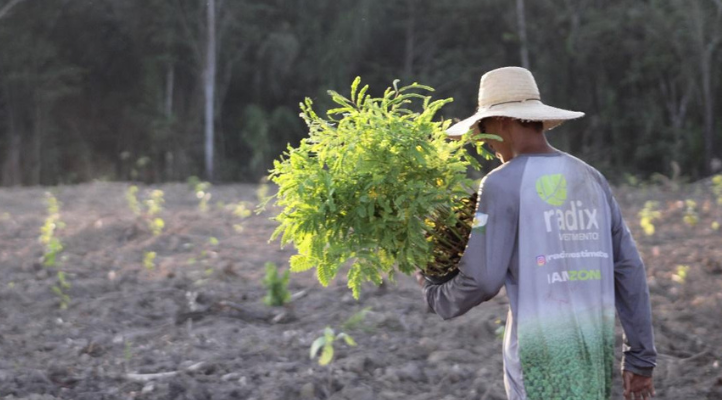Startup supported by Fundo Vale plans to remove 21 million tons of CO2 through productive restoration planting

Using its know-how in forestry systems and in the recovery of the Amazon Rainforest, as well as recent support from Fundo Vale as part of Vale’s 2030 Forest Goal, Radix Investimentos Florestais is now targeting the carbon market. The greentech company aims to sequester 21 million tons of CO2 from the atmosphere in 50 years, helping Brazil play a leading role on the international ecological transformation agenda, by attracting investment and aiding economic, social and environmental development.
“Our successional, productive restoration planting model gives us some advantages in terms of operational, productive and financial metrics for carrying out this operation, as well as a sustainable growth path. It’s as if the forest were financially promoting its own re-establishment,” says Gilberto Derze, founding partner of Radix.
The company, founded in 2015, plants commercial tropical timber forests and has now turned its attention to the restoration and decarbonization market, offering a carbon offset mechanism for companies to eliminate their emissions of polluting gases while financing environmental recovery and preservation.
R$1.3 million of funding from Fundo Vale boosted the project, which was implemented in 2023. “The Forest Goal aims to protect and restore 500,000 hectares by 2030 and carbon credits play an important role in this process. The program directs financial support to impact businesses, and Radix’s work in recovering degraded areas, removing CO2 and preserving biodiversity is highly relevant,” says Helio Laubenheimer, a carbon specialist at Fundo Vale.
Brazil’s leading role in the carbon market
Carbon credit trading grew by 65% globally from 2020 to 2021, according to Climate Focus. It has gained momentum due to perceptions of climate change and its effects, such as floods and global warming. People are more aware of environmental issues and they are looking for sustainable products and companies with ESG responsibility.
“This certainly sets up a system in which society puts pressure on companies, which need to establish decarbonization policies combined with offsetting their emissions in order to maintain their existing customers, attract new ones and comply with international guidelines. To attract foreign investment at low interest rates, companies in Brazil must adhere to a process of decarbonizing their production systems,” says Derze.
Brazil has the potential to be a global leader in the decarbonization process and the fight against climate change, as it accounts for 15% of the global potential for carbon capture by natural means and has the scope to meet 48.7% of global demand, according to a study by consulting firm McKinsey.
“The country has a vast area within the tropical belt, which allows it, for example, to achieve higher productivity in the production of timber and other crops capable of sequestering greenhouse gases,” Derze says.
The situation is promising for Brazil, given the vastness of its natural forests, a possible shift in production models for agricultural activities and the importance of the ESG agenda. According to McKinsey, demand for carbon credits could expand 15-fold by 2030 and 100-fold by 2050, from US$1 billion in 2021 to US$50 billion in 2030.
As companies commit to reaching zero net carbon emissions, the prospect of Brazil becoming carbon neutral by 2050 is becoming increasingly real.
“The country is in a unique position to emerge as a protagonist in this race. Our electricity generation sources are predominantly clean and renewable, we are pioneers in the use of biofuels and we have a vast wealth of natural resources, offering major opportunities for environmental conservation and carbon removal through nature-based solutions,” points out Laubenheimer, who works to stimulate businesses with innovative solutions at Fundo Vale.
By positioning itself as a leader, Brazil will gain environmental, commercial and social benefits. “We should focus on attracting investment not only in forest preservation and restoration projects, but above all in social and human development issues, since the areas with the most potential to sequester carbon are also those with the least development and quality of life,” says Derze.
